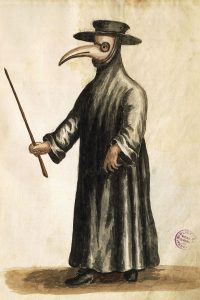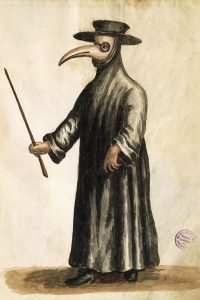
No matter how bad the present coronavirus pandemic gets, it will ultimately pale in comparison to the deadliest plague in human history. It can be comforting to put things in historical perspective. It could be worse, and just seven centuries ago, it sure was.
The year was 1347. The Mongol siege of the Crimean port city of Caffa on the Black Sea collapsed from within: a devastating disease the invaders brought unwittingly from China killed them in droves and sapped the morale of those it spared. Before the dispirited Mongols retreated, they engaged in one last assault. Deploying their wooden catapults, they hurled the bodies of their dead over the walls and into the city in an early example of biological warfare.
A half century earlier, Caffa had been purchased from the Mongols by merchants and shippers from the Republic of Genoa in present-day Italy. They turned it into a thriving trade center, but also home to one of the world’s biggest slave markets of the day, until relations with the Mongols deteriorated into open warfare.
When the bodies of plague victims landed within their walls, the people of Caffa escaped by boat and sailed to Genoa, Venice, and Pisa—along with the disease and the rats and fleas that served as its primary carriers. In a matter of weeks, the Italian peninsula became the new epicenter of a contagion known as “Bubonic Plague” or the “Black Death.” It would eventually wipe out at least a third and perhaps as much as half of Europe’s human population.
Fifty-six thousand people died in a single month in the city of Marseilles, France. Florence, Italy, saw 50 percent of its 100,000 inhabitants wiped out. In some of the hardest-hit villages, three-quarters of the citizens perished in short order.
Robert S. Gottfried tells us that the Black Death arrived in London in late September 1348. London was England’s largest town but was home to a mere 50,000 people crowded into a single, unsanitary square mile. The plague’s toll was staggering in its dimensions:
Scheduled to convene in Westminster in autumn 1349, Parliament never assembled. The Black Death lingered until late spring 1350 and killed between 35% and 40% of London’s population—a figure that some scholars would raise as high as 50%. Since London offered excellent opportunities for social and economic advancement, and was a magnet for immigrants, its population probably began to rise as soon as the plague had subsided. Still, the city would not have 50,000 people again until early in the sixteenth century.
Gottfried’s account is one of several excellent books about the Black Death. I’ve listed others among the recommended readings below. If this era interests you, don’t miss the classic work of Giovanni Boccaccio called The Decameron. This Amazon description of the 14th Century classic may whet your appetite:
Set during the Black Death, The Decameron is a collection of 100 tales told by a group of seven young women and three young men, hunkered down in self-imposed quarantine as they waited out the pandemic plague then sweeping through Florence. The stories of The Decameron range from the erotic to the tragic to the comic, from frivolous practical jokes to meaningful life lessons. One of the most significant and influential works of European literature, it is considered to be a masterpiece of classical early Italian prose.
Today’s measures to combat the COVID-19 virus will be best assessed in hindsight, but some of them are clearly invasive and destructive of the civil rights free people cherish; a few of them may also be shown in time to have been ineffective or counterproductive in combating the virus itself. In any event, as I wrote in “A Nation’s True Test Comes After the Crisis” and in “A Virus Worse than the One from Wuhan,” we must be vigilant or a short-term problem will be transformed into long-term tyranny.
Nonetheless, responses to the Black Death in the 14th Century make ours so far today seem tepid.
In his riveting history, The Black Death, historian Philip Ziegler reports instances of homes of the sick being walled off, leaving the inhabitants to die inside. Bodies by the dozens, even hundreds, were buried in shallow graves, only to be dug up and spread around by wild animals. Intentional bleeding was widely regarded as a useful preventative as well as a palliative—but of course, it accomplished little more than to weaken those subjected to it.
In some benighted quarters, the ailment was blamed on unpopular minorities (such as Jews or gypsies), leading to persecutions and massacres. For hundreds of thousands, if not millions, of Europeans, the “treatment” proved worse than the disease.
John Kelly, in The Great Mortality, reveals that local government bureaucrats sometimes seized advantage of the crisis. For example, in Florence: “During 1348,” he writes, “municipal officials stole 375,000 gold florins from the inheritances and estates of the dead.” Widespread crime and disorder became the excuse to impose draconian penalties and persecutions.
It took four years of agony for the Black Death that started in 1347 to run its course, but it would take 200 years for the population of Europe to reach its pre-plague level.
Let’s be thankful that we live in the 21st Century, not the 14th.
For additional reading, see:
“Black Death and Taxes” by B. K. Marcus
The Decameron by Giovanni Boccaccio
The Black Death: Natural and Human Disaster in Medieval Europe by Robert S. Gottfried
The Great Mortality: An Intimate History of the Black Death, the Most Devastating Plague of All Time by John Kelly
The Black Death by Philip Ziegler
“The Peasant’s Revolt of 1381: A Rip-snorter of a Tax Rebellion” by Lawrence W. Reed
Lawrence W. Reed is FEE’s President Emeritus, Humphreys Family Senior Fellow, and Ron Manners Global Ambassador for Liberty, having served for nearly 11 years as FEE’s president (2008-2019). He is author of the 2020 book, Was Jesus a Socialist? as well as Real Heroes: Incredible True Stories of Courage, Character, and Conviction and Excuse Me, Professor: Challenging the Myths of Progressivism. Follow on LinkedIn and Like his public figure page on Facebook. His website is www.lawrencewreed.com.
This article was originally published on FEE.org. Read the original article.
